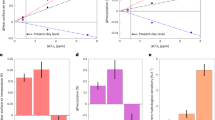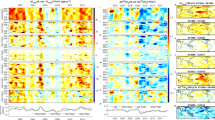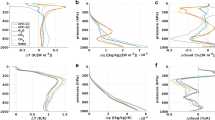Abstract
Atmospheric methane (CH4) mixing ratios exhibited a plateau between 1995 and 2006 and have subsequently been increasing. While there are a number of competing explanations for the temporal evolution of this greenhouse gas, these prominent features in the temporal trajectory of atmospheric CH4 are expected to perturb the surface energy balance through radiative forcing, largely due to the infrared radiative absorption features of CH4. However, to date this has been determined strictly through radiative transfer calculations. Here, we present a quantified observation of the time series of clear-sky radiative forcing by CH4 at the surface from 2002 to 2012 at a single site derived from spectroscopic measurements along with line-by-line calculations using ancillary data. There was no significant trend in CH4 forcing between 2002 and 2006, but since then, the trend in forcing was 0.026 ± 0.006 (99.7% CI) W m2 yr−1. The seasonal-cycle amplitude and secular trends in observed forcing are influenced by a corresponding seasonal cycle and trend in atmospheric CH4. However, we find that we must account for the overlapping absorption effects of atmospheric water vapour (H2O) and CH4 to explain the observations fully. Thus, the determination of CH4 radiative forcing requires accurate observations of both the spatiotemporal distribution of CH4 and the vertically resolved trends in H2O.
This is a preview of subscription content, access via your institution
Access options
Access Nature and 54 other Nature Portfolio journals
Get Nature+, our best-value online-access subscription
$29.99 / 30 days
cancel any time
Subscribe to this journal
Receive 12 print issues and online access
$259.00 per year
only $21.58 per issue
Buy this article
- Purchase on Springer Link
- Instant access to full article PDF
Prices may be subject to local taxes which are calculated during checkout





Similar content being viewed by others
References
Myhre, G. et al. in Climate Change 2013: The Physical Science Basis (eds Stocker, T. F. et al.) Ch. 8 (IPCC, Cambridge Univ. Press, Cambridge, 2013).
Dlugokencky, E. J., Nisbet, E. G., Fisher, R. & Lowry, D. Global atmospheric methane: budget, changes and dangers. Phil. Trans. R. Soc. Lond. Ser. A 369, 2058–2072 (2011).
Nisbet, E. G., Dlugokencky, E. J. & Bousquet, P. Methane on the rise—again. Science 343, 493–495 (2014).
Kirschke, S. et al. Three decades of global methane sources and sinks. Nat. Geosci. 6, 813–823 (2013).
Aydin, M. et al. Recent decreases in fossil-fuel emissions of ethane and methane derived from firn air. Nature 476, 198–201 (2011).
Kai, F. M., Tyler, S. C., Randerson, J. T. & Blake, D. R. Reduced methane growth rate explained by decreased Northern Hemisphere microbial sources. Nature 476, 194–197 (2011).
Schaefer, H. et al. A 21st century shift from fossil-fuel to biogenic methane emissions indicated by 13CH4. Science 352, 80–84 (2016).
Prather, M. J. & Holmes, C. D. Overexplaining or underexplaining methane’s role in climate change. Proc. Natl Acad. Sci. USA 114, 5324–5326 (2017).
Rigby, M. et al. Role of atmospheric oxidation in recent methane growth. Proc. Natl Acad. Sci. USA 114, 5373–5377 (2017).
Turner, A. J., Frankenberg, C., Wennberg, P. O. & Jacob, D. J. Ambiguity in the causes for decadal trends in atmospheric methane and hydroxyl. Proc. Natl Acad. Sci. USA 114, 5367–5372 (2017).
Bergamaschi, P. et al. Atmospheric CH4 in the first decade of the 21st century: inverse modeling analysis using SCIAMACHY satellite retrievals and NOAA surface measurements. J. Geophys. Res. 118, 7350–7369 (2013).
Turner, A. J. et al. A large increase in U.S. methane emissions over the past decade inferred from satellite data and surface observations. Geophys. Res. Lett. 43, 2218–2224 (2016).
Miller, S. M. et al. Anthropogenic emissions of methane in the United States. Proc. Natl Acad. Sci. USA 110, 20018–20022 (2013).
Brandt, A. R. et al. Methane leaks from North American natural gas systems. Science 343, 733–735 (2014).
Harries, J. E., Brindley, H. E., Sagoo, P. J. & Bantges, R. J. Increases in greenhouse gas forcing inferred from outgoing longwave spectra of the Earth in 1970 and 1997. Nature 410, 355–357 (2001).
Griggs, J. A. & Harries, J. E. Comparison of spectrally resolved outgoing longwave radiation over the tropical Pacific between 1970 and 2003 using IRIS, IMG, and AIRS. J. Clim. 20, 3982–4001 (2007).
Myhre, G., Highwood, E. J., Shine, K. P. & Stordal, F. New estimates of radiative forcing due to well mixed greenhouse gases. Geophys. Res. Lett. 25, 2715–2718 (1998).
Etminan, M., Myhre, G., Highwood, E. J. & Shine, K. P. Radiative forcing of carbon dioxide, methane, and nitrous oxide: a significant revision of the methane radiative forcing. Geophys. Res. Lett. 43, 12614–12623 (2016).
Brown, L. R. et al. Methane line parameters in the HITRAN2012 database. J. Quant. Spectrosc. Rad. Trans. 130, 201–219 (2013).
Goody, R. M. & Yung, Y. L. (eds) in Atmospheric Radiation: Theoretical Basis Ch. 3 (Oxford Univ. Press, New York, 1989).
Rothman, L. S. et al. The HITRAN2012 molecular spectroscopic database. J. Quant. Spectrosc. Rad. Trans. 130, 4–50 (2013).
Kratz, D. P. The sensitivity of radiative transfer calculations to the changes in the HITRAN database from 1982 to 2004. J. Quant. Spectrosc. Rad. Trans. 109, 1060–1080 (2008).
Lu, P., Zhang, H. & Jing, X. The effects of different HITRAN versions on calculated long-wave radiation and uncertainty evaluation. Acta Meteor. Sin. 26, 389–398 (2012).
Delahaye, T. et al. Measurements of H2O broadening coefficients of infrared methane lines. J. Quant. Spectrosc. Rad. Trans. 173, 40–48 (2016).
Mlawer, E. J. et al. Development and recent evaluation of the MT_CKD model of continuum absorption. Phil. Trans. R. Soc. A 370, 2520–2556 (2012).
Turner, D. D. & Ellingson, R. G. The Atmospheric Radiation Measurement Program: The First 20 Years (Amer. Meteor. Soc., Boston, 2016).
Feldman, D. R. et al. Observational determination of surface radiative forcing by CO2 from 2000 to 2010. Nature 519, 339–343 (2015).
Helmig, D. et al. Reversal of global atmospheric ethane and propane trends largely due to US oil and natural gas production. Nat. Geosci. 9, 490–495 (2016).
Hausmann, P., Sussmann, R. & Smale, D. Contribution of oil and natural gas production to renewed increase in atmospheric methane (2007–2014): top-down estimate from ethane and methane column observations. Atmos. Chem. Phys. 16, 3227–3244 (2016).
Wild, M. et al. The global energy balance from a surface perspective. Clim. Dynam. 40, 3107–3134 (2013).
Wang, K. & Liang, S. Global atmospheric downward longwave radiation over land surface under all-sky conditions from 1973 to 2008. J. Geophys. Res. 114, D19101 (2009).
Stephens, G. L. et al. An update on Earth’s energy balance in light of the latest global observations. Nat. Geosci. 5, 691–696 (2012).
Xie, S. et al. Clouds and more: ARM climate modeling best estimate data. Bull. Am. Meteor. Soc. 91, 31–20 (2010).
Knuteson, R. O. et al. Atmospheric emitted radiance interferometer. Part I: Instrument design. J. Atmos. Ocean. Technol. 21, 1763–1776 (2004).
Biraud, S. C. et al. A multi-year record of airborne CO2 observations in the US Southern Great Plains. Atmos. Meas. Tech. 6, 751–763 (2013).
Huang, Y., Tan, X. & Xia, Y. Inhomogeneous radiative forcing of homogeneous greenhouse gases. J. Geophys. Res. 121, 2780–2789 (2016).
Jung, M. et al. Recent decline in the global land evapotranspiration trend due to limited moisture supply. Nature 467, 951–954 (2010).
Gero, P. J. & Turner, D. D. Long-term trends in downwelling spectral infrared radiance over the U.S. Southern Great Plains. J. Clim. 24, 4831–4843 (2011).
Willett, K. M. et al. HadISDH: an updateable land surface specific humidity product for climate monitoring. Clim. Past 9, 657–677 (2013).
Dai, A. Recent climatology, variability, and trends in global surface humidity. J. Clim. 19, 3589–3606 (2006).
Berry, D. I. & Kent, E. C. A new air-sea interaction gridded dataset from ICOADS with uncertainty estimates. Bull. Am. Meteor. Soc. 90, 645–656 (2009).
Simmons, A. J., Willett, K. M., Jones, P. D., Thorne, P. W. & Dee, D. P. Low frequency variations in surface atmospheric humidity, temperature, and precipitation: inferences from reanalyses and monthly gridded observational data sets. J. Geophys. Res. 115, D01110 (2010).
Wentz, F. J., Ricciardulli, L., Hilburn, K. & Mears, C. How much more rain will global warming bring? Science 317, 233–235 (2007).
Anderson, G. P. et al. AFGL Atmospheric Constituent Profiles (0–120 km) AFGL-TR_86-0110 (AFGL, 1989).
Atmospheric Emitted Radiance Interferometer (AERICH1). 2000-01-01 to 2015-06-01, 36.605 N 97.485 W: Southern Great Plains (SGP) Central Facility, Lamont, OK, Atmospheric Radiation Measurement (ARM) Climate Research Facility Data Archive (ARM Data Discovery, accessed 1 June 2016); https://doi.org/10.5439/1025143
ARM Best Estimate Data Products (ARMBEATM). 2002-01-01 to 2012-12-31, 36.605 N 97.485 W: Southern Great Plains (SGP) Central Facility, Lamont, OK (C1). Compiled by X. Chen and S. Xie. Atmospheric Radiation Measurement (ARM) Climate Research Facility Data Archive (ARM Data Discovery, accessed 1 June 2015); https://doi.org/10.5439/1039931
Rienecker, M. M. et al. MERRA: NASA’s modern-era retrospective analysis for research and applications. J. Clim. 24, 3624–3648 (2011).
Peters, W. et al. An atmospheric perspective on North American carbon dioxide exchange: CarbonTracker. Proc. Natl Acad. Sci. USA 104, 18925–18930 (2007).
Hall, B. D., Dutton, G. S. & Elkins, J. W. The NOAA nitrous oxide standard scale for atmospheric observations. J. Geophys. Res. Atmos. 112, D09305 (2007).
Clough, S. A. et al. Atmospheric radiative transfer modeling: a summary of the AER codes. J. Quant. Spectrosc. Rad. Trans. 91, 233–244 (2005).
Rothman, L. S. et al. The HITRAN 2008 molecular spectroscopic database. J. Quant. Spectrosc. Rad. Trans. 110, 533–572 (2009).
Alvarado, M. J. et al. Impacts of updated spectroscopy on thermal infrared retrievals of methane evaluated with HIPPO data. Atmos. Meas. Tech. 8, 965–985 (2015).
Li, J. Gaussian quadrature and its application to infrared radiation. J. Atmos. Sci. 57, 753–765 (2000).
Turner, D. D., Knuteson, R. O., Revercomb, H. E., Lo, C. & Dedecker, R. G. Noise reduction of Atmospheric Emitted Radiance Interferometer (AERI) observations using principal component analysis. J. Atmos. Ocean. Technol. 23, 1223–1238 (2006).
Wang, J. et al. Corrections of humidity measurement errors from the Vaisala RS80 Radiosonde – application to TOGA COARE data. J. Atmos. Ocean. Technol. 19, 981–1002 (2002).
Turner, D. D. et al. Dry bias and variability in Vaisala radiosondes: The ARM experience. J. Atmos. Ocean. Technol. 20, 117–132 (2003).
Weatherhead, E. C. et al. Factors affecting the detection of trends: Statistical considerations and applications to environmental data. J. Geophys. Res. 103, 17149–17161 (1998).
Liu, X., et al. OMI ozone profile and tropospheric ozone and cross evaluations with chemical transport models, AGU Meeting of the Americas, A31A-22 (2013).
Kuhn, M. & Johnson, K. Regression Trees and Rule-Based Models in Applied Predictive Modeling (Springer, New York, 2013).
Shumway, R. H. & Stoffer, D. S. Time Series Analysis and Its Applications (Springer, New York, 2000).
Ivosev, G., Burton, L. & Bonner, R. Dimensionality reduction and visualization in principal component analysis. Anal. Chem. 80, 4933 (2008).
Frank, R. J., Davey, N. & Hunt, S. P. Time series prediction and neural networks. J. Intell. Robot. Syst. 31, 91–103 (2001).
Casella, G. & Berger, R. L. (eds) in Statistical Inference Ch. 7.2.2 (Duxbury Press, Ithaca, 2002).
Ravishanker, N. & Dey, D. A First Course in Linear Model Theory (Chapman and Hall/CRC, Boca Raton, 2002).
Casella, G. & Berger, R. L. (eds) in Statistical Inference Ch. 10.4 (Duxbury Press, Ithaca, 2002).
Gilks, W. R., Richardson, S. & Spiegelhalter, D. J. Markov Chain Monte Carlo in Practice (Chapman and Hall/CRC, Boca Raton, 1995).
Kass, R. E. & Raftery, A. E. Bayes factors. J. Am. Stat. Assoc. 90, 773–795 (1995).
Bouwman, A. F., Boumans, L. J. M. & Batjes, N. H. Modeling global annual N2O and NO emissions from fertilized fields. Glob. Biogeochem. Cycles 16, 1080 (2002).
Fulton, R. A., Breidenbach, J. P., Seo, D. J., Miller, D. A. & O’Bannon, T. The WSR-88D rainfall algorithm. Weather Forecast. 13, 377–395 (1998).
Thoning, K. W., Tans, P. P. & Komhyr, W. D. Atmospheric carbon-dioxide at Mauna Loa observatory. 2. Analysis of the NOAA GMCC data, 1974–1985. J. Geophys. Res. 94, 8459–8565 (1989).
McFarlane, S. A. ARM’s Progress on Improving Atmospheric Broadband Radiative Fluxes and Heating Rates (AMS, 2016); https://doi.org/10.1175/AMSMONOGRAPHS-D-15-0046.1
Bruhwiler, L. M. et al. CarbonTracker-CH4: an assimilation system for estimating emissions of atmospheric methane. Atmos. Chem. Phys. 14, 8269–8293 (2014).
McFarlane, S., Shippert, T. and Mather, J. Radiatively Important Parameters Best Estimate (RIPBE): An ARM Value-Added Product DOE Technical Report SC-ARM/TR-097 (US Department of Energy, 2011).
Dlugokencky, E. J., Steele, L. P., Lang, P. M. & Masarie, K. A. The growth rate and distribution of atmospheric methane. J. Geophys. Res. 99, 17021–17043 (1994).
Knuteson, R. O. et al. Atmospheric emitted radiance interferometer. Part II: Instrument performance. J. Atmos. Ocean. Technol. 21, 1777–1789 (2004).
Acknowledgements
This material is based on work supported by the Director, Office of Science, Office of Biological and Environmental Research of the US Department of Energy (DOE) under contract no. DE-AC02-05CH11231 as part of their Atmospheric System Research (ASR) Program, the Atmospheric Radiation Measurement (ARM) Program, the Terrestrial Ecosystem Sciences (TES) Programs, and the ARM Aerial Facility (AAF). Resources of the National Energy Research Scientific Computing Center (NERSC) were used under the same contract. Work at LLNL was performed under the auspices of the US DOE by Lawrence Livermore National Laboratory under contract no. DE-AC52-07NA27344. M. Alvarado, K. Cady-Pereira, L. Riihimaki, I. Simpson and P. Novelli also contributed. NOAA GMD provided flask CH4, C2H6 and N2O data.
Author information
Authors and Affiliations
Contributions
D.R.F. led the research, performed all calculations and wrote the manuscript; W.D.C. proposed the study concept, provided research guidance and conceived methods for isolating the CH4 signal; S.C.B. provided CH4 and N2O data and associated support; M.D.R. provided the statistical analysis; D.D.T. provided guidance on AERI instrument performance and research focus; P.J.G. helped interpret AERI data; J.T. analysed thermodynamic contributions to the observed forcing. D.H. provided C2H6 data and associated support; S.X. provided ARMBE data and associated support; E.J.M. and T.R.S. provided clear-sky error analysis; M.S.T. provided research feedback and guidance and served as the principal investigator of the grant supporting this research. All authors discussed the results and commented on the manuscript.
Corresponding author
Ethics declarations
Competing interests
The authors declare no competing interests.
Additional information
Publisher’s note: Springer Nature remains neutral with regard to jurisdictional claims in published maps and institutional affiliations.
Supplementary information
Supplementary Information
Supplementary Tables and Figures.
Rights and permissions
About this article
Cite this article
Feldman, D.R., Collins, W.D., Biraud, S.C. et al. Observationally derived rise in methane surface forcing mediated by water vapour trends. Nature Geosci 11, 238–243 (2018). https://doi.org/10.1038/s41561-018-0085-9
Received:
Accepted:
Published:
Issue Date:
DOI: https://doi.org/10.1038/s41561-018-0085-9
This article is cited by
-
First-principles study on methane storage properties of porous graphene modified with Mn
Applied Physics A (2021)
-
Effect of Drought-Induced Salinization on Wetland Methane Emissions, Gross Ecosystem Productivity, and Their Interactions
Ecosystems (2020)
-
On the Causes and Consequences of Recent Trends in Atmospheric Methane
Current Climate Change Reports (2019)



